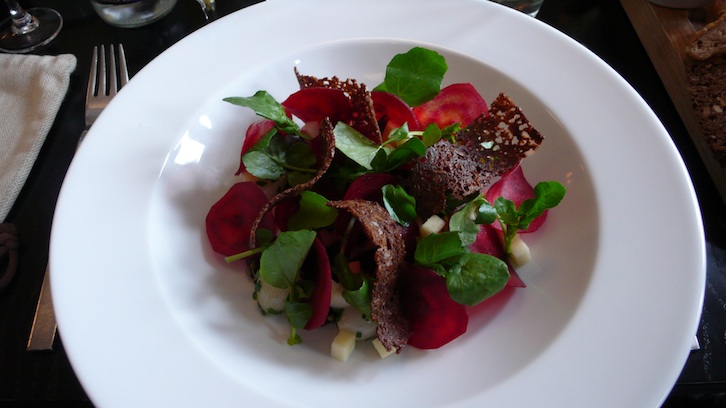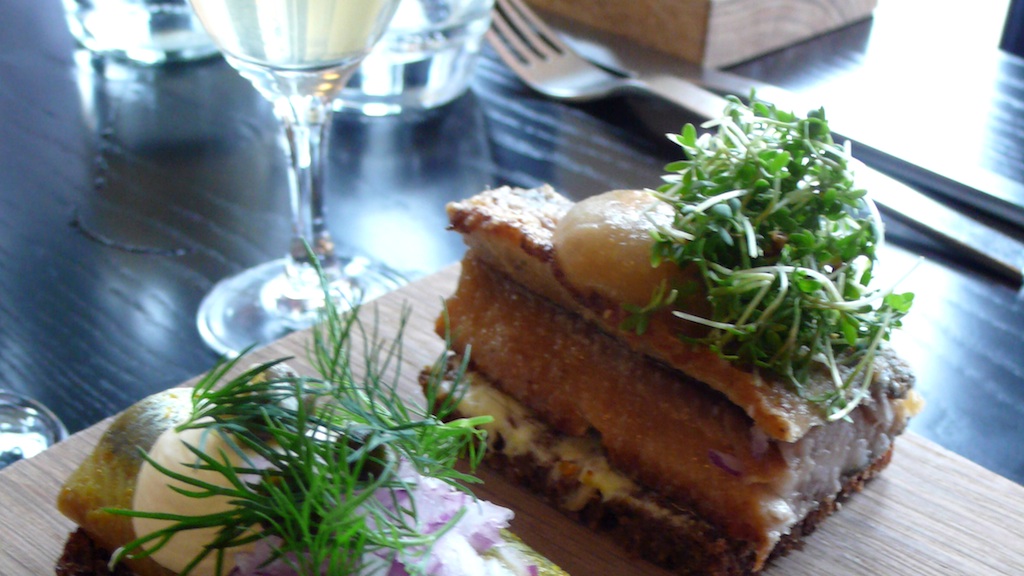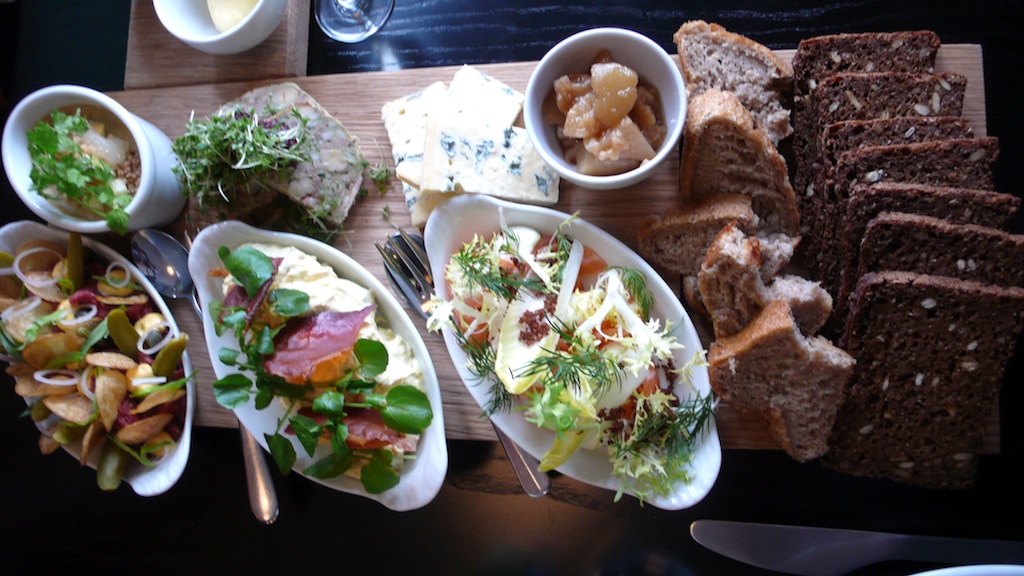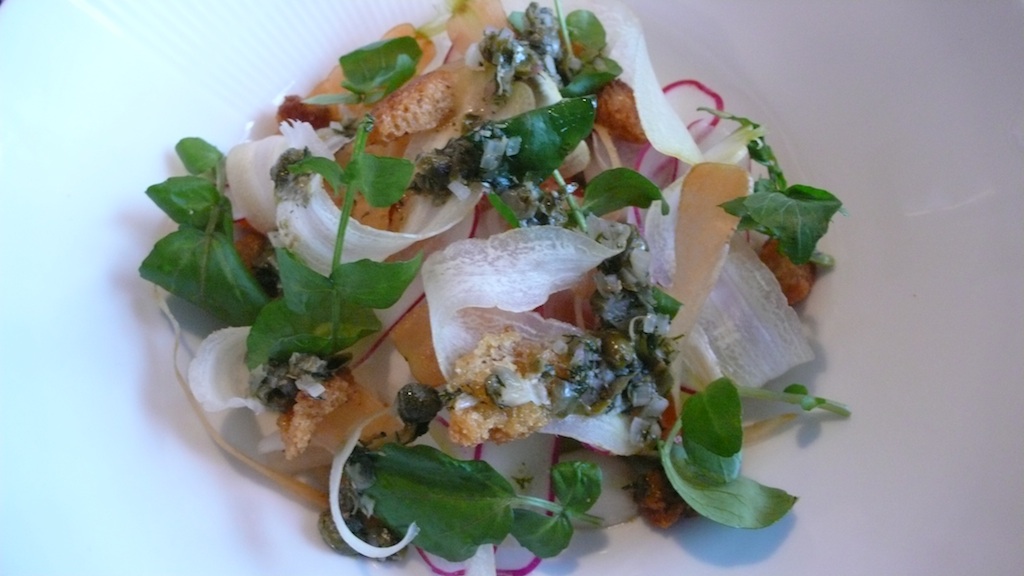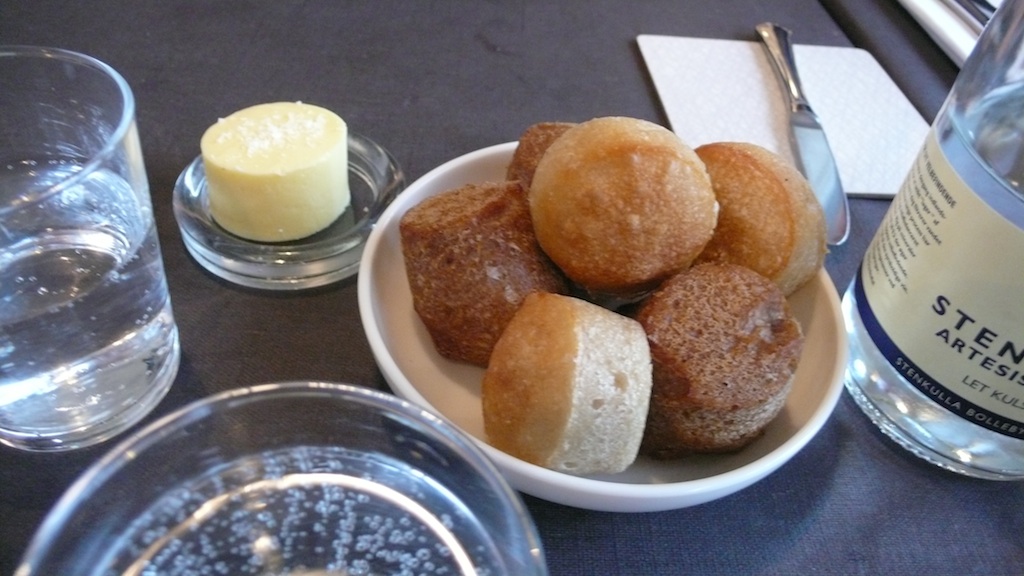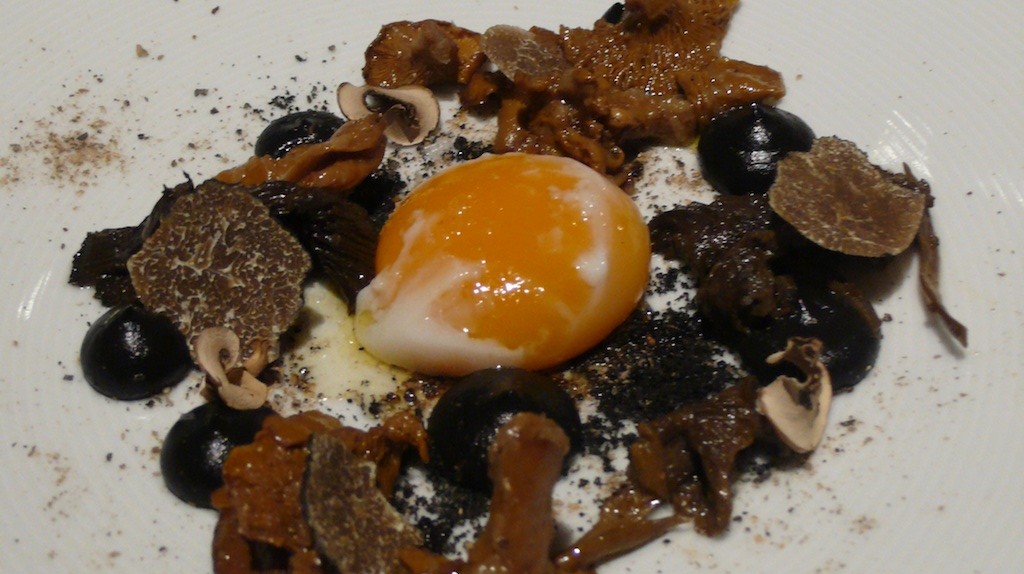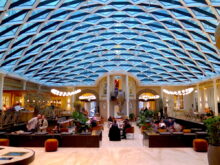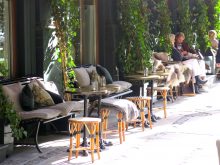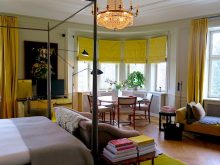It’s completely understandable that Denmark has long held a fascination for so many gay people. After all, it was Denmark that gave us modern home design. (Where would “Mad Men” be without Danish contemporary furniture? And, really, could any of us endure our apartments furnished in American colonial?)
Furthermore, Denmark was the first country in the world to legalize civil unions in 1989 – as well as the country where the first widely-known “sex change” was performed in 1952. For gay people of a certain age, transsexual Christine Jorgensen made Denmark look like a bastion of openness and tolerance during a time when the US was pursuing a witch-hunt on gay people in American society. And Denmark was also the first country in the world to legalize pornography – in 1969. And, by the spring of 2012, Denmark is expected to legalize same-sex marriage.
And where would ballet be without the Danes? Much of the reputation of American ballet companies – and specifically the New York City Ballet – rests on the shoulders of those tall and elegant Danish ballet dancers.
And Hans Christian Andersen, Danish fairy tale writer? If he wasn’t completely gay (most authorities suggest “bisexual), then he certainly understood a gay sensibility. For what is “The Ugly Duckling” but the fervent hope of every gay man? “Make me a swan!”
As if we need any more evidence, Denmark is also home to the oldest monarchy in Europe. Hello, Queens and Princesses?
Yes, Denmark has, for years, existed as a kind of idyllic world for gay people. (And we haven’t even mentioned that precursor to Disneyland, Tivoli Gardens – or Karen Blixen (aka Isak Dinesen, author of “Out of Africa” and “Babette’s Feast”) whose many works, written under a male pseudonym, celebrate homosexuality.)
While, admittedly, we’re trading in LGBT stereotypes here, we’re also talking about the pursuit of art and beauty – and the art of living well, all of which are primary components of Denmark and its people. There is a Danish word that nicely encapsulates many attributes of Danish culture, a word that almost defies translation. That word is “hygge” and you see it in store windows and on signage and you sometimes see it modified with adjectives, so that during the holiday season you might see “Jule Hygge” or “Dessert + Hygge.”
When asked for a translation, the word “bliss” is sometimes offered with a shrug of the shoulders. “Bliss” is not precise, nor is “hospitality” – but “hygge” exists somewhere in the intersection of those two concepts – and a recent trip to Copenhagen confirmed that Denmark’s capital is positively “hygge.”
Copenhagen regularly appears on the indices of the world’s most livable cities, which is certainly connected to the fact that nine in ten Danish adults own – and ride – a bicycle. Imagine the difference between a car horn and a bicycle horn, and the difference in air quality – and the absence of traffic noise, as well as a population of well-toned people with beautiful hamstrings, thighs – and glutes. (And the word for that is “callipygous.” Look it up, for real.)
All over the city, bicycles rule – and everyone adheres to the bike lane rules (woe to the poor dazed tourist who steps into the path of a fleet of bikers). More than fifty percent of city citizens use their bicycles daily. Cargo bikes traverse the city, carting everything from luggage, children, animals, groceries to Christmas trees and full-length sofas. Cargo bike micro-businesses include pedal-powered blender bikes that make your morning smoothie. As with Los Angeles where you are your car, in Copenhagen, your bicycle becomes an integral part of your identity.
In a country widely honored for its wind energy industries, Copenhagen recently initiated a climate program with the goal of becoming the first world capital to be carbon neutral by 2025. The city’s Metro is open 24/7, making cars an unnecessary indulgence. And in keeping with Copenhagen’s green projects, city authorities encourage beekeeping, with more than 4.5 million bees currently helping to sustain the city’s innate sweetness.
As creative as it is eco-minded, Copenhagen has been, of late, widely celebrated for its culinary innovation. Since the opening in 2004 of René Redzepi’s restaurant Noma (a Danish acronym for “Nordic food”), the city has become the nexus of New Nordic cuisine – and with Noma winning the title of “World’s Best Restaurant” for the past two years, foodies have been flocking here from around the world.
Just as Ferran Adria’s elBulli (where Redzepi worked early in his career) inaugurated a foodie fascination with Spain and molecular gastronomy, so, too, has Noma regenerated an entire gastronomic culture in Denmark. More than 4,000 miles of coastline provides a copious bounty from the sea – and, currently, Copenhagen has more Michelin-starred restaurants per capita than anywhere else in the world. Restaurants helmed by Noma alumni have opened all over town, reviving neighborhoods that were previously considered parlous – and the subsequent waves of eateries devoted to indigenous and sustainable cuisine have resulted in a city that has become Europe’s new foodie heaven.
A stroll down one street – a street named Jaegersborggade, in the heart of Nørrebro – reveals the breadth of Copenhagen’s current culinary offerings. There is the city’s finest specialty micro-roastery, the Coffee Collective, which was started by the World Barista Champion and twice National Champion. Across the street is Restaurant Relae, with Chef Christian Puglisi, formerly of elBulli and Noma. And over there is Manfreds, Puglisi’s newest eatery, a biodynamic enoteca. The small street is also home to Karamelleriet, the city’s only caramel cookery, as well as Gourmand Claus Meyer and his Meyer Bakery. And there’s also Ro Chokolade, which utilizes raw ingredients to create hand-made chocolates in flavors such as elderflower juice, honey, and Champagne.
Oh, and there’s also the fact that Copenhagen currently holds the title of “World’s Best Chef” for Geranium Chef Rasmus Kofoed whose vegetarian mother helped shape his distinctive culinary style.
While it’s possible to spend one’s time eating through Copenhagen – have we mentioned smørrebrød, the Danish open-faced sandwich with a whole-grain rye bread base currently experiencing a renaissance, thanks to Adam Aamann and his eponymous restaurants? – there is also design. (Food and design: it’s no wonder that a certain type of gay man considers this city to be heaven.)
World-famous since the 1950s, Danish design is defined by its sleek lines, simplicity, and functionality. The Danish Modern furniture that we often associate with Palm Springs and “Mad Men” was designed and produced with the philosophy of using design to improve people’s lives. Danish designers such as Arne Jacobsen, Verner Panton, Jacob Jensen, and Finn Juhl created furniture during the Fifties and Sixties that was marked by its affordability and notable for its timelessness.
Juhl was the designer behind the United Nations Trusteeship Council Chamber (which is currently undergoing renovation and refurbishment in time for Juhl’s centennial year in 2012) – and it was primarily Juhl who introduced the Danish Modern aesthetic to the States.
The understated and refined design sensibility of post-war Denmark lives on in many neighborhoods of Copenhagen. Many locals head to Nansensgade, a little oasis within the city where “Nordic cool” reigns. In this neighborhood, there are no international clothing chains or brand stores; instead, a visitor will find up-and-coming fashion and furniture designers, funky cafés and bike shops, specialized bookstores, and vintage boutiques. On the corner of Nansensgade and Vendersgade is the landmark red neon HOTEL sign of Ibsens Hotel, where artists from the neighborhood have participated in the refurbishment of the hotel’s decor.
One of the many joys of walking around Copenhagen is counting the number of times you’re falling in love again: with the barista at Coffee Collective, with the manboy who wraps your bouquet of roses, with the waiter at Manfreds, with the boy on the bicycle who stops for the light and winks as you cross the street. Everywhere you wander, you can’t help but marvel at the tall and lean Danes, as long-legged as giraffes, their posture as perfect as a corps of dancers, walking and biking with a kind of inner calm in an almost blissful state.
And the children, so blond and well-mannered! Even a notorious child-hater such as W.C. Fields might be forced to reconsider his aversion in the face of such angelic beauty.
After spending a few days in Copenhagen eating at restaurants where a meal of foraged foods and biodynamic wine is as celebrated as hospitality and kindness (and where “Michelin-star attitude” is virtually non-existent), and where one walks off a gourmet meal by wandering through neighborhoods pervaded by a neo-progressivism, it’s easy to feel as if modern Danish culture has found the secret.
In other words, contrary to Shakespeare, very little appears rotten in the state of Denmark – and, in fact, in keeping with the spirit of both “hygge” and New Nordic cuisine, modern Danish culture seems to imply that happiness is to be found in the world around us.
“We must cultivate our gardens,” wrote Voltaire. The Danes are showing us how.
WHERE TO STAY:
Ibsens Hotel: For nearly thirty years, since 1982, the Brøchner family has been housing guests in hotels that beautifully exemplify the Danish spirit of “hygge” – and that sense of blissful hospitality is pervasive throughout a stay at one of the four Copenhagen hotels that comprise the Brøchner Hotels group.
“It’s in our hearts” is the Brøchner Hotels company motto, so perhaps it is not surprising to feel immediately at home upon crossing the threshold of Ibsens Hotel. Located in the charmingly bohemian neighborhood of Nansengade (right down the street from the brand-new produce and food hall, Torvehallerne), Ibsens was acquired by the Brøchner family in 1997 – and completely redesigned in 2011.
In keeping with the Brøchner Hotels philosophy, the owners sought out local artisans to help furnish the boutique hotel – and the result is a hotel-cum-gallery, with both permanent and temporary art exhibitions on display in the cafe and courtyard and throughout the building’s six floors.
All of the Ibsens’ 118 rooms offer free WiFi/Internet and cable TV and are colorfully decorated in a clean, spare, and slightly retro style. The design sensibility is similar to Ace Hotel, complete with turntable and vinyl records in the downstairs lounge. Guests include fashionable hipsters as well as beautiful blond children accompanied by parents who appear to have stepped from a Banana Republic catalog.
On Friday nights, Ibsens hosts a music night, complete with DJ and live music, which brings in locals from the neighborhood who mingle gregariously with hotel guests. The atmosphere is more laidback cool than insufferably hot – and again, a reflection of that Danish “hygge,” which the Brøchner family seems to serve intuitively.
A block from the Copenhagen lakes, and a mere five minutes from the world’s longest pedestrian shopping thoroughfare, Ibsens is also connected to the Hotel Kong Arthur, another of the Brøchner Hotels. Guests at Ibsens can choose from among the two properties’ five restaurants – and then soak off the indulgences in Copenhagen’s largest spa.
Breakfast at Ibsens is a fresh and healthy buffet that features smoothies, muesli, yogurt, berries, nuts, croissants – and rye bread sandwiches that are so toothsome and delicious that it’s nearly impossible to eat only one. Request a wake-up call so that you can linger at the “mingle tables” where you’ll meet fellow travelers as fascinating as you.
With bicycles for rent, as well as an electric car called “Buddy,” Ibsens is part of the world’s first carbon-neutral hotel chain, an honor held since 2008. Ibsens is also the first hotel in the world to accept Artmoney (bills created by artists in exchange for goods or services) – and the breakfast room wall is covered by framed Artmoney bills (available for purchase for approximately $40).
Ibsens is the sort of hotel that particularizes aspects of your most favorite homes. Claim it as yours.
LINK: Ibsens Hotel
WHAT TO DO:
Ordrupgaard Art Museum: Five miles north of the city center, in the tony suburb of Charlottenlund, not so far from Dyrehaven (the Royal Deer Park), there exists a sanctuary of art and architecture. What was once a private manor house, built in 1918 by a noted art collector, is now the Ordrupgaard Art Museum. Not unlike the Frick in New York, another museum housed in the former private home of a collector, Ordrupgaard holds an exquisite collection of art, primarily French and Danish.
A quick train ride away from Copenhagen’s city center and you find yourself walking through a leafy, bucolic neighborhood and up the drive to the entrance of this state-owned art museum. Bequeathed to Denmark in 1953, the Ordrupgaard also features a black lava concrete addition built by the prize-winning Iraqi architect, Zaha Hadid. The extension, which doubles the museum’s size, opened in 2005 – and has, predictably, increased Ordrupgaard’s profile amongst architecture fanatics.
In fact, a day spent at Ordrupgaard is an architecture aficionado’s dream day, for the museum also owns the neighboring home of the groundbreaking Danish architect, Finn Juhl. Juhl designed the Trusteeship Council Chamber at the United Nations Headquarters in New York in 1951-52, and his home, situated right next door to the Ordrupgaard, is preserved as he left it and filled with furniture of his own design.
Born in 1912, Juhl built his home within sight of the Ordrupgaard in 1942 and the L-shaped house remains as a perfect example of Juhl’s architectural theories – as well as a time capsule of timeless Danish design.
To be surrounded by the works of such innovative thinkers and philanthropists is inspiring – but if all the heady atmosphere proves enervating, relax in the cafe in the Hadid addition with a cup of perfect Danish coffee. You’ll be reminded again how it appears that everything is right in the state of Denmark.
LINK: Ordrupgaard Art Museum
National Galley of Denmark: Denmark’s preeminent museum for visual art is housed in an 1896 Italian Renaissance revival building, juxtaposed with a modernist addition built in 1998. A glass-roofed “Sculpture Street,” complete with footbridges, links the two buildings. The collection includes more than 500 years of European art, including works by Titian, Rubens, and Rembrandt, and an acclaimed collection of French art with works by Matisse, Derain, Braque, and Picasso – but the primary reason for visiting might be the collection of Danish and Nordic Art (1750-1900), representing the “Golden Age” of Danish visual art. The contemporary Danish cafe in the modernist addition overlooks a beautiful park – and perhaps best of all, the entire collection is free. “700 Years of Art – For Free” is the museum’s tagline – and what could be more inviting?
LINK: National Galley of Denmark
Copenhagen Cool: In a city as cool as Copenhagen, you can’t help but yearn to learn the city’s secrets – which is exactly what Copenhagen Cool offers.
Imagine a friend who knows all the right places, the best vintage shops, the trendy boutiques, the cool cafés and the hot bars and restaurants, where to buy your coffee, and where to walk at sunset. That’s Copenhagen Cool’s specialty: showing you around the city and making you feel as if you’re living like the local who’s always in the know.
Copenhagen Cool’s website is a treasure trove of insider knowledge – and in English! – and if you book a tour with Copenhagen Cool, you’ll be walking the city’s streets with a new best friend.
LINK: Copenhagen Cool
Copenhagen Pride: Ever since Copenhagen was the host city for Europride 1996, Copenhagen Pride has worked to create a festival that celebrates the LGBTQ community and its inherent connection to the fabric of this multifarious city. Every year, Copenhagen Pride takes over one of Copenhagen’s beautiful squares to create Pride Square. Apart from the Parade, there is a massive Pride Show at City Hall, as well as LGBT Midsummer and numerous parties at various clubs. Copenhagen Pride is held in August, when Copenhagen’s weather is the most clement.
LINK: Copenhagen Pride
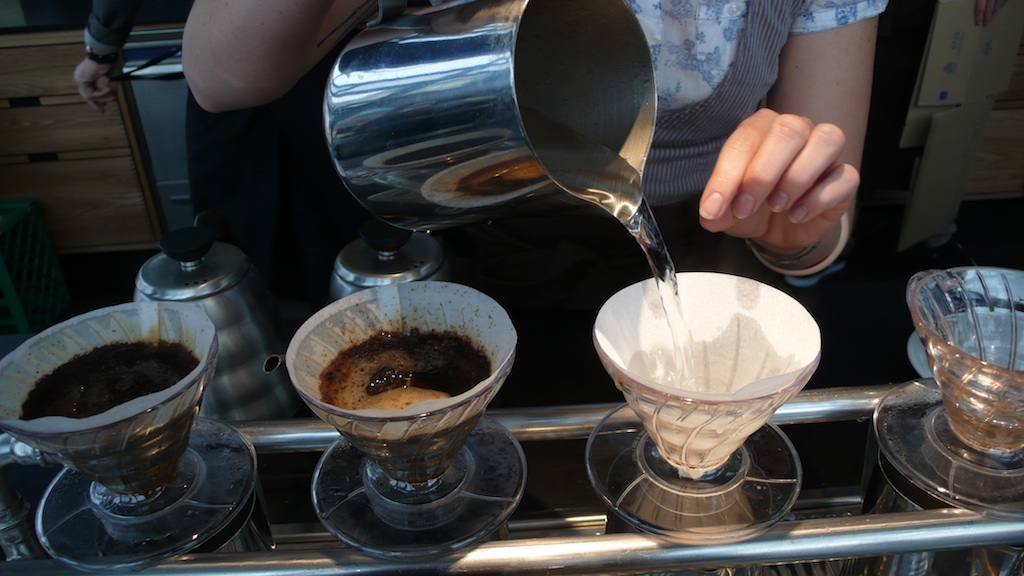
Every cup of coffee at the Coffee Collective is prepared with professionalism and attention to detail. (Source: MRNY)
WHERE TO EAT:
Geist: There are some meals that you are certain you will never forget – and, from now on, the mere mention of the word “celeriac” will transport me back to Chef Bo Bech’s restaurant Geist.
Another of the New Nordic culinary wizards, Bech was formerly with Paustian, which he left in 2010 to open Geist. Meaning “ghost” or “spirit,” Geist is located beneath a blackened archway in an interior courtyard, thereby creating the sense of arriving at a private residence whose owner might be a composite of Dorian Gray and Beetlejuice.
Heavy teak doors give way to marble counters and dove-gray upholstered booths. The ceilings in the dimly-lit bathrooms are completely covered by mirrors, which, when complemented by an eerie soundtrack of creaking and squeaking, fosters the sense that one is not entirely alone.
The food at Geist is as imaginative as it is timeless, somewhat akin to a precocious gourmand hanging about his grandmother’s kitchen and following his own instincts while also learning at her side. The menu includes such satisfying fare as Jerusalem artichoke with poached egg and barley, or potatoes with mussels and chestnuts.
Mashed potatoes, made with brown stone crab and salted butter, is precisely the kind of dish that one might consider as a last meal – and given that the comely server informed us, “It’s fifty percent butter,” it might well be. Oh, but what a way to go.
Black lobster with mustard seed and pickled baby tomatoes was as resonant as a painting by Rothko – and redolent of late summer’s bounty. Desserts include caramelized pear with sorrel and yogurt, and the Danish classic “risalamande,” a kind of rice pudding, which, in Bech’s hands includes pomelo and tonka bean. Ambrosial is the word that comes to mind.
As for the celeriac, it’s baked with condensed buttermilk and arrives on a plate, looking somewhat like an oversized baked potato on a sea of ochre paint. Again, the somewhat monochromatic appearance brings Rothko to mind. Biting into this celeriac, which almost floats on your palate, is equivalent to understanding the inherent philosophy of the New Nordic cuisine: the elevation of the earthly into food fit for the gods. Hauntingly delicious, a meal at Geist lingers in your spirit long after you’ve left Copenhagen.
LINK: Geist
Norrebro Bryghus: Housed in a former metal factory and located in the newly-rediscovered Norrebro neighborhood, Norrebro Bryghus is one of Scandinavia’s most acclaimed microbreweries. Opened in the late summer of 2003, the brewery was so popular that, initially, it ran out of beer. Since then, Norrebro Bryghus has brewed more than 28 different types of beer, offering beers for every taste, including sweet, sour, bitter, strong, mild, and dry. Up to ten different types of hand-brewed beer are available daily, all of which can be enjoyed in a 160-seat restaurant that serves seasonal, sustainable cuisine. In the summer, there’s a courtyard beer garden – but no matter the season, that Danish sense of “hygge” is always in abundance at Norrebro Bryghus.
LINK: Norrebro Bryghus
Aamanns Etablissement: One of the meals most likely to provoke sighs of “hygge” from the Danes is the traditional “smørrebrød.” These open-faced sandwiches, borne of farmers and workers, are an integral part of Danish culinary traditions, complete with their own dining protocol for the smørrebrød purists.
Chef Adam Aamann opened Aamanns Smørrebrødsdeli in 2006, focusing on natural and seasonal ingredients in his pursuit to revive and rejuvenate (and rescue from mayonnaise) the classic Danish lunch. Aamann’s efforts to elevate the beloved smørrebrød to a gastronomic art form resulted in numerous awards and honorifics – and the designation “Lunch Restaurant of the Year” in 2008.
Aamanns Etablissement, Aamann’s fine dining establishment, opened in 2009, right next door to its sister, serving afternoon and evening meals in a understated dining room that, with a design sleight of hand, manages to be, at the same time, both modern and evocative of a classic 19th-century Danish eating club. The convivial atmosphere is bolstered by the accompanying tastings of the house-brewed aquavits (or “snaps”), including such esoteric flavors as sea buckthorn and tansy (also known as mugwort). The hearty house-baked rye bread is a revelation – and an afternoon meal at Aamann’s will remind you of the virtues of taking time for lunch.
Those living in New York will gain firsthand knowledge of Chef Aamann’s gustatory genius when Aamanns New York opens in January 2012. Given Aamann’s success, don’t be surprised if 2012 becomes “Year of the Smørrebrød.”
LINK: Aamanns Etablissement
Den Gule Cottage: After a morning spent at the Ordrupgaard Art Museum, you might think about stopping in Klampenborg for lunch at “The Yellow Cottage.” The idyllic cottage with its roof clock sits on a hillock overlooking Bellevue Beach (with its Arne Jacobsen-designed lifeguard towers). Originally built as a gatekeeper house for a spa resort in 1844, the yellow cottage was preserved in 1978 – and now houses a charming restaurant with enchanting views of the sound. Picnic baskets can be purchased – but regardless of whether you eat in the cottage or on the beach, make certain that you eat at least two rolls, slathered with butter. This is the kind of bread that you dream about when you’ve returned to the States.
Drive along the water on your way back into town for a view of the Arne Jacobsen-designed gas station, at which you almost expect to see George and Judy Jetson appear at the door.
You couldn’t ask for a lovelier afternoon.
LINK: Den Gule Cottage
Kodbyens Fiskebar: Not so long ago, Vesterbro in Copenhagen was the center of the city’s sex industry, as well as the neighborhood with more butchers per square kilometer than anywhere else in Europe. In other words, meat and more meat – and now, even more meat, thanks to the burgeoning culinary scene that has transformed Copenhagen’s meatpacking district in much the same fashion as Manhattan.
While the meatpackers still flourish, the neighborhood has become widely recognized for its cutting-edge galleries, clubs, bars, and restaurants. One of the first restaurants to open to critical acclaim and popular appeal was Fiskebar, which was predicated on the idea that the city needed a comfortably casual place to eat the copious bounty which comes from the surrounding sea.
Since its opening in June of 2009, Fiskebar (helmed by Noma alumni, naturally) has remained the kind of insider, industrial chic restaurant where notables such as architect Bjarke Ingels (of BIG, aka Bjarke Ingels Group) hang at the bar for some of the city’s most innovative and fresh seafood. The restaurant’s distressed decor, complete with broken tiles, evokes an abandoned fish house, reopened for business after a long sabbatical. There’s even a cylindrical tank of jellyfish.
In keeping with Copenhagen’s thriving gustatory renaissance, the staff at Fiskebaren appears to possess an almost encyclopedic knowledge of seafood and Danish culinary traditions – and is delighted to sit down at your table and answer any questions while steering you toward the best meal possible.
Menus are divided into a series of small dishes and main courses. Plates at Fiskebar are as splendid to photograph and contemplate as they are to taste – and then devour. Oysters and razor clams with fennel, tarragon, and dill look as beautiful as if they’ve dressed for the Mermaid Parade. A plate of wild mushrooms from “a secret place in the woods” with a poached egg and truffles from Gotland is the epitome of farm and field and every bit as indulgent and luxurious as Champagne at midnight.
For dessert, there’s sea buckthorn sorbet and licorice cake, with baked rose hip rice pudding. The presentation is as artful as a painting by Jean Miro.
Throughout the evening, the energy at Fiskebar remains celebratory – and it’s easy to believe that you’ve found the party for which you’ve spent years searching. Dining at Fiskebaren is one definition of culinary bliss.
LINK: Kodbyens Fiskebar
Manfreds & Vin: Copenhagen’s Jægersborggade Street might well be the Rodeo Drive of gastronomy. Various alumni of Noma have opened restaurants on this picturesque street in Norrebro, including Chef Christian Puglisi, one of the Wall Street Journal’s “Top Ten Chefs of 2010.” Formerly affiliated with both elBulli and Noma, Chef Puglisi has two acclaimed restaurants on Jægersborggade. After a stint as a take-away joint with limited seating, Manfreds & Vin opened late in 2011 with a dining room behind the self-service counter.
Deliberately furnished like an unfinished industrial loft, complete with plywood bar and concrete walls, Manfreds attracts a hipster crowd of foodies that, on certain nights, resembles a fashion shoot in Williamsburg, Brooklyn. Lanky and lean waiters are equally cool – and extremely enthusiastic about what Manfreds produces for the table.
Biodynamic produce is complemented by biodynamic wines, which are perfectly paired, thanks to a knowledgeable waitstaff, all of whom serve the food and spirits with a kind of laidback bonhomie. Small plates of supremely fresh produce of impeccable quality are served when they are prepared – rather than adhering to a dining protocol of starter, entree, and dessert. The resultant meal is a kind of family style meal – that is, if your family included a well-known celebrated chef. Vegetables (with biodynamic herbs) are the stars here, including kohlrabi spaghetti – and everything is reasonably priced, and particularly for fine dining.
With Manfreds, Puglisi is throwing down the gastronomic gauntlet to show that world-class cuisine can be available to all – and after a meal at Manfreds, you’ll wonder why all haute establishments don’t have the same sense of joie de vivre and relaxation. Manfreds makes fine dining fun.
LINK: Manfreds & Vin
Kiin Kiin: There’s only one Michelin-starred Thai restaurant in all of Scandinavia – and that’s Chef Henrik Yde-Andersen’s Kiin Kiin. Opened in September 2006 in Norrebro, which was, at that time, a neighborhood where few tourists ventured, Andersen’s restaurant created such a buzz that the neighborhood grew up around it and is now home to stylish cafes, clubs, and restaurants.
Kiin Kiin (meaning “Eat, eat” in Thai) serves modern Thai cuisine in a stunning setting designed by the Panta Group, which is known for furniture made from water hyacinth and bamboo. A lounge on the ground floor is a sanctuary of Thai hospitality, while the dining room on the second floor is sleek and contemporary.
Andersen’s innovative homage to Thai street food includes such succulent morsels as cashew meringue with soy, lotus roots with lime leaves, spiced tamarind salad, and peanut ginger ice cream with crispy chicken skin and satay crumble. Everything that crosses your lips awakens your palate to a flurry of sensations and textures. As Andersen explains, he was mesmerized by his first tastes of Thai cuisine while visiting Thailand – and since then, Andersen has given those who frequent Kiin Kiin a similar gustatory epiphany. As charismatic as he is gifted in the kitchen, Andersen has subsequently opened several Asian restaurants around Copenhagen, as well as a restaurant at the Siam Kempinski Hotel in Bangkok.
A meal at Kiin Kiin is revelatory – and one leaves the restaurant with a wide-eyed appreciation for the manner in which Andersen’s food awakens the senses and the spirit.
LINK: Kiin Kiin
The Coffee Collective: The definitive Danish coffee micro-roastery, Coffee Collective is run by the World Barista Champion, Klaus Thomsen, and his partners who include the World Cup Tasting Champion, an acclaimed roast master, and an architect. These people are passionate about coffee – and about global cooperation and sustainable production – and everyone employed at Coffee Collective works to provide their clientele with exceptional coffee.
To order at Coffee Collective is not only an education, but also a sensual pleasure, reminding you anew what you love most about coffee. Every cup is prepared with professionalism and attention to detail – the entire five-step, five-minute process is fascinating to witness – and it’s little wonder that numerous celebrated eateries around the city serve Coffee Collective at meal’s end. This is coffee to fall in love with (and probably ruin you for nearly all other cups of Joe).
LINK: The Coffee Collective
WHERE TO SHOP:
Torvelhallerne: Since 1889, Israels Plads (Square), an expansive plaza in the center of Copenhagen, has been a farmers’ market – but it was only after a decade-long renovation project that the square reopened in September 2011 with brand-new, covered market halls encompassing more than 75,000 square feet of exhibition space.
The result is Torvehallerne, an inviting food and vegetable market with 100 interior and exterior stalls housing purveyors of Danish specialties and high-quality produce from small farms. With numerous shopping and dining options, restaurants and cafés, juice bars and florists, as well as a branch of the Coffee Collective, Torvelhallerne feels as welcoming as the Ferry Building Marketplace in San Francisco. You’ll be tempted to linger – and if the weather is inclement, you’ll happily pull up a stool at this modern realization of an urban square.
LINK: Torvelhallerne
Magasin du Nord: Established in 1868, and located in its current location since 1871, Magasin offers the breadth of contemporary Danish life in a French neo-Renaissance, wedding cake of a building that emulates the architectural style of the Louvre in Paris.
When the department store’s entire silhouette is outlined in white lights during the holiday season, it’s nearly impossible to resist Magasin’s siren call. Succumb to the temptation and immerse yourself in Scandinavian high fashion. Magasin (also known as Magasin du Nord, for its predecessor, Hotel du Nord) also houses its own chocolate factory, which produces Magasin Chocolate, by appointment to the Danish monarchy.
LINK: Magasin
Sögreni Cykler: Started in 1981, during Denmark’s “poor decade” when abandoned bicycles were littering Copenhagen’s streets, Sögreni now collaborates with the likes of Georg Jensen, Sir Terence Conran, and the Swedish design house, Källemo.
All Sögreni bicycles are built by hand and adjusted to perfection. Walk into the store and be seduced, not only by the beauty of bicycle design but also by Sögreni himself.
Sögreni bicycles are the pinnacle of Danish simplicity and attention to detail. As much a work of art as a means of transport, a Sögreni is, without question, the Rolls-Royce of the bike lane.
LINK: Sogreni Bikes
WHERE THE GAYS GO:
Oscar: Named for the Irishman who reminded us that anything can be resisted except temptation, Oscar’s is an establishment that befits Mr. Wilde’s sublime taste in both men and food. During the day, Oscar’s serves brunch (including a full English breakfast), as well as lunch, coffee, tea, cake, snacks, and dinner.
On the Friday evening that we strolled in, buckets of Champagne lined the 40-foot long bar, placed there for a surfeit of dazzling Danes and their elegant friends. You could almost hear Oscar marveling, as he murmured, “The only way to get rid of temptation is to yield to it.”
LINK: Oscar
Centralhjørnet: Arguably the oldest gay bar in Copenhagen, there’s little doubt that Centralhjørnet is one of the liveliest. As soon as you cross the threshold, you have the feeling that you’ve entered a party at Holly Golighty’s apartment. Located in the heart of the city, within sight of City Hall (where the first gay civil unions in Europe were performed), Centralhjørnet is a nexus of Copenhagen gay life. Just as with the End-Up in San Francisco, everyone ends up at Centralhjørnet.
LINK: Centralhjørnet
GETTING THERE:
SAS Scandinavian Airlines: SAS Scandinavian Airlines flies direct from Newark (or D.C. or Chicago) to Copenhagen’s Airport with a crew that is as professional as it is fun-loving. The pervasive sense of joie de vivre was completely in evidence during last year’s “Love Is In the Air” flight where the entire crew serenaded two newlywed LGBT couples with their own version of “I Am What I Am” before serving wedding cake at 38,000 feet in the air.
If you are fortunate enough to fly SAS Business Class, you’ll find yourself inclined to remain on the plane – even upon landing at your destination. The entire flight in SAS Business Class is a class in cosseting, enhanced by a self-massaging chair that’s more comfortable than most beds. SAS Business Class bathrooms have windows. Think about that. And there are fresh flowers and linens. Meal service in SAS Business features New Nordic cuisine paired with the sommelier’s choice wines.
Apart from SAS Business Class, there is also SAS Economy Extra, which was recently named the world’s best in a survey by nearly 40,000 travelers, all of whom travel in a class other than economy. Introduced in 2001, SAS Economy Extra was the first premium economy class offering wider seats and enough leg room to insure you remain flexible throughout the flight.
Upon experiencing SAS Economy Extra, the reasons for the award become understandable – for the rewards are ample. The duvets are plush and there are full meals (including Danish smørrebrød at 38,000 feet) with copious amounts of wine – and mid-flight treats such as gelato.
And certainly one of the best parts of flying SAS from Copenhagen is the SAS Business Lounge at Copenhagen’s Airport. A two-level capacious oasis, the SAS Business Lounge offers everything a global nomad might desire, including showers, entertainment, full meals, cafeteria service, and peace and quiet.
SAS Business Lounge is worth at least an extra hour at the airport – to decompress and relax in style before your flight.
LINK: SAS Scandinavian Airlines
ADDITIONAL INFORMATION:
Click here for MRNY slideshow of Copenhagen.
For LGBTQ information, go to: www.visitdenmark.com/gay www.visitcopenhagen.com/gay
For Wonderful Copenhagen, go to: www.visitcopenhagen.com
For Visit Denmark, go to: www.visitdenmark.com/usa
For the Denmark tourist newsletter, go to: www.visitdenmark.com/usa/en-us/menu/turist/nyheder/newsletter/usa-newsletter-tourist.htm
For a very cool smørrebrød app for your iPhone, go to: www.visitdenmark.com/smorrebrodapp
For a free cell phone/mobile guide to Copenhagen, go to Appstore or Android Market: VisitCopenhagen For the Copenhagen Card, which provides free admission to more than 65 museums and attractions, as well as free transport by bus, train, and Metro (available in either 1- or 3-day increments), contact: touristinfo@woco.dk

